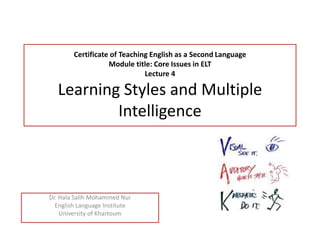
Learning styles and multiple intelligence
- 1. Certificate of Teaching English as a Second Language Module title: Core Issues in ELT Lecture 4 Learning Styles and Multiple Intelligence Dr. Hala Salih Mohammed Nur English Language Institute University of Khartoum
- 2. What are learning styles? • Learning styles are simply different approaches or ways of learning. • Many theories developed for the LS. The most important are David Kolb’s Learning Style and Howard Gardner VAK model.
- 3. Multiple Intelligence Theory was first published in Howard Gardner's book, Frames Of Mind (1983), and quickly became established as a classical model by which to understand and teach many aspects of human intelligence, learning style, personality and behaviour - in education and industry. Howard Gardner initially developed his ideas and theory on multiple intelligences as a contribution to psychology, however Gardner's theory was soon embraced by education, teaching and training communities, for whom the appeal was immediate and irresistible - a sure sign that Gardner had created a classic reference work and learning model.
- 4. Howard Gardner’s MIC • Gardner’s Multiple Intelligence concept divide the human intelligence into 7 domains: Intelligence type capability and perception Linguistic Words and language Logical-Mathematical logic and numbers Musical music, sound, rhythm Bodily-Kinesthetic body movement control Spatial-Visual images and space Interpersonal Interact with people Intrapersonal self-awareness
- 5. Visual-Auditory-Kinesthetic VAK Model by Gardner According to the VAK model, most people possess a dominant or preferred learning style, however some people have a mixed and evenly balanced blend of the three styles. A person's learning style is a reflection of their mix of intelligences. It is also a reflection of their brain type and dominance learning style description Visual seeing and reading Auditory listening and speaking Kinesthetic touching and doing
- 6. David Kolb's learning styles model and experiential learning theory (ELT) Having developed the model over many years prior, David Kolb published his learning styles model in 1984. The model gave rise to related terms such as Kolb's experiential learning theory (ELT), and Kolb's learning styles inventory (LSI).
- 7. Kolb's learning theory sets out four distinct learning styles (or preferences), which are based on a four-stage learning cycle. Kolb's model therefore works on two levels - a four-stage cycle: Concrete Experience - (CE) Reflective Observation - (RO) Abstract Conceptualization - (AC) Active Experimentation - (AE)
- 8. This theory lead to a four-type definition of learning styles, (each representing the combination of two preferred styles, rather like a two-by-two matrix of the four-stage cycle styles, as illustrated below), for which Kolb used the terms: Diverging (CE/RO) Assimilating (AC/RO) Converging (AC/AE) Accommodating (CE/AE)
- 10. Diverging (feeling and watching - CE/RO) – * able to look at things from different perspectives. *sensitive. *best at viewing concrete situations several different viewpoints. *perform better in situations that require ideas-generation, for example, brainstorming. *have broad cultural interests and like to gather information to solve problems. *interested in people, tend to be imaginative and emotional, and tend to be strong in the arts. *prefer to work in groups, to listen with an open mind and to receive personal feedback.
- 11. Assimilating (watching and thinking - AC/RO) – *concise, logical approach. Ideas and concepts are more important than people. *require good clear explanation rather than practical opportunity. *excel at understanding wide-ranging information and organising it a clear logical format. *are more attracted to logically sound theories than approaches based on practical value. *important for effectiveness in information and science careers. *formal learning situations, people with this style prefer readings, lectures, exploring analytical models, and having time to think things through.
- 12. Converging (doing and thinking - AC/AE) – *can solve problems and will use their learning to find solutions to practical issues. *prefer technical tasks, and are less concerned with people and interpersonal aspects. *are best at finding practical uses for ideas and theories. *can solve problems and make decisions by finding solutions to questions and problems. *are more attracted to technical tasks and problems than social or interpersonal issues. *enables specialist and technology abilities. *like to experiment with new ideas, to simulate, and to work with practical applications.
- 13. Accommodating (doing and feeling - CE/AE) – *'hands-on', and relies on intuition rather than logic. *use other people's analysis, and prefer to take a practical, experiential approach. *are attracted to new challenges and experiences, and to carrying out plans. *act on 'gut' instinct rather than logical analysis. *tend to rely on others for information than carry out their own analysis. *prevalent and useful in roles requiring action and initiative. * prefer to work in teams to complete tasks. *set targets and actively work in the field trying different ways to achieve an objective.
